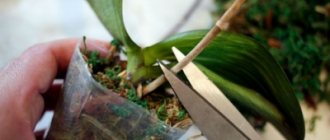Why is pruning needed?
There are a number of reasons for pruning Chinese roses:
- The ability to get rid of irregularly shaped branches:
- too long;
twisted;
- deformed.
Rejuvenation. Lack of proper care for hibiscus will result in the flower spending all its energy on old shoots. Flowering will become sparse, and the crown will not gain lushness.- Sanitary pruning allows you to get rid of shoots affected by disease or pests and prevent the disease from spreading to healthy branches.
- Root pruning is justified only if they grow strongly. This type of pruning also accelerates the growth of hibiscus and promotes abundant flowering.
Over time, new branches will grow in their place.
When to do the procedure?
When is it better to carry out the procedure: in February, before spring, or in the fall? The main pruning of Chinese roses is carried out in February. Insignificant - in September, after flowering. If you ignore autumn pruning, old side shoots will grow back. But there will be no flowering (why might hibiscus not bloom?). After all, buds appear exclusively on young shoots.
Important: the more often this procedure is performed, the more magnificent the crown will be and the more abundant the flowering.
In summer you should refrain from pruning. There will be no flowering after summer pruning.
Frequency and time of the procedure
Garden hibiscus should be pruned annually, and more than once:
- Spring pruning stimulates the growth of new shoots in the plant, which means luxurious flowering in the summer. It is the pruning of the plant in the spring that determines the decorativeness of the bush. Therefore it is mandatory.
- At the end of flowering, the plant is pruned again. This is done in the fall, which gives impetus to the growth of side shoots.
- It is strictly forbidden to prune in winter. Otherwise, in the summer you will not get such long-awaited flowering.
Pruning a home flower
How can you prune a house flower? Depending on the age of the plant, its condition and the expected shape of the crown, there are 5 types of pruning:
- Topping suitable for young plants.
- This is the most gentle type of pruning.
- Used to stimulate growth.
- It consists of removing the tops of all branches above the top node.
You need to pinch when the plant is about 13 - 15 cm high.- To strengthen the trunk when pinching, the central shoot is attached to a base (for example, to a bamboo skewer).
- Selective cropping carried out not only to stimulate growth, but also to maintain the shape of the plant. This type of pruning is a more thorough shortening of branches: several already well-developed internodes are cut off. Certain areas that disrupt the shape of the crown are trimmed.
The sequence of this type of hibiscus pruning is as follows:- Trim the side shoots, leaving up to 4 - 5 leaves.
Make the cut just above the node, leaving at least 2/3 of the branch.
- Branches growing parallel to the central trunk and inside the crown also need to be pruned.
- Pruning should be done above the growing point, which faces outward.
Reference: the cut is made at an angle of 45 degrees. - Full pruning ensures abundant flowering of the plant. Produced in early spring to obtain abundant flowering. When fully pruned, each branch is shortened to two to three buds.
- Sanitary pruning involves removing disease-damaged areas of the plant. The cut is made until living wood appears. If the cut is green, then the branch is alive. A brown and white branch cut requires immediate pruning.
When pruning, do not try to leave as many shoots as possible. Don't be afraid to trim! Even if you cut off the excess, the plant will survive everything. Pruning tools must be sharp and disinfected.
Hibiscus hedge
Hibiscus is becoming increasingly popular in the garden as a hedge. This requires special pruning in the autumn months, resulting in a compact hedge shape, and in summer numerous flowers grow on fresh shoots. Pruning should be done in September or October as follows:
- Full cut to one third
- Complete pruning every year
- Trim dried branches, especially in the inner area
Trim your hibiscus hedge so that it is slightly tapered at the top to improve lighting. And in turn reduces the likelihood of premature aging of the internal region of the plant.
Radical pruning of hibiscus
This pruning is especially recommended if the hibiscus has previously suffered greatly from disease or has uneven growth. In most cases, hibiscus tolerates such pruning normally. Such pruning will be the solution to healthy and vigorous growth, but the plant does not always recover after such a procedure.
Therefore, it is recommended to carry out radical pruning over several years. This means that each year the hibiscus is pruned a little more in the fall than the year before. Pruning can continue until the first branch on the main stem is approximately five to ten centimeters above the ground.
How to form a crown at home?
Formative pruning is the most difficult type of hibiscus pruning.
Purpose of the procedure and the best time for it
The Chinese rose is formed in order to obtain the desired shape of the crown and the entire plant. The more often the crown can be shaped by pruning, the better the plant will develop and achieve the correct shape.
They begin to form a crown in the spring, after the plant’s dormant period ends. The shape of the hibiscus is maintained through selective pruning.
How to trim a bush correctly in spring?
The rules for pruning hibiscus depend on what type of crown is expected to be obtained after the procedure. It can be a lush tree, a branched shrub, or a miniature bush.
- To form a Chinese rose in the form of a tree, you should:
- Remove side branches.
- Leave a couple of medium branches, shortening them by only 2 - 3 buds. In the future this will be the main trunk.
- To form a hibiscus in the form of a lush bush you need:
- Trim the middle-most upper branches. At the same time, the lateral buds will begin to form new shoots.
- Shorten the central branch, leaving only a few growing points.
- To form a lush crown:
- Remove all useless branches: internal, parallel to the main trunk, gnarled, deformed and growing inward.
- Clear the crown of faded flowers in a timely manner. This promotes the development and blooming of new buds.
How to pinch?
Pinching young shoots will not be harmful to hibiscus. This should be done in early spring. You can pinch everything - it won’t hurt them in any way.
You need to pinch hibiscus like this: tie the central shoot to a support, and cut off all the side shoots, leaving 3-5 leaves. A bamboo stick is most often used as a support. If you don’t have one at hand, you can use a pencil, knitting needle or other handy material that is useful for this role. Due to this procedure, the trunk will become thicker.
It must be remembered that at this time you need to actively feed the plant with nitrogen. When the flower grows to the desired length, you need to pinch its crown, leaving 5-6 well-developed shoots. This is the future crown - it needs to be trimmed more often to get thick branches.
It is imperative to cut off the so-called “tops” - shoots that grow parallel to the main trunk. Branches growing inside the crown also need pruning.
So, all plants require pruning, including hibiscus. It is not only designed to improve the appearance of the flower, but also has a good effect on its health and condition .
Prune after each flowering - in spring and autumn. You should not carry out this procedure in the fall. You need to use regular scissors. There are two ways to form the crown of a plant: create a lush crown and a horizontal one. Pinching is also extremely necessary. This will help the young shoots grow faster, which means there will be more buds and flowers.
Look how beautiful the Chinese rose is after pruning!
Caring for Chinese roses immediately after crown formation
The first time after pruning, the Chinese rose needs adaptation:
- Place the plant in a cool corner.
- Cover from direct sunlight.
- Limit watering.
Further care for a trimmed houseplant is no different from usual:
- Watering with warm, settled water as the top layer of soil dries.
- Air humidity is about 50%.
- Spraying and rinsing in the shower. Wiping the leaves with a damp cloth will also work. For the full development of the Chinese rose, the leaves of the flower must be constantly free of dust.
- Feed once a month with complex fertilizers.
- Ventilate the room, but avoid drafts. In summer, it is preferable to take the hibiscus out into the fresh air.
- The lighting should be bright but diffuse.
What to do if the plant begins to wither?
Wilting of hibiscus after pruning is quite rare. The flower is absolutely calm about pruning. And if this happens, the reason lies in a violation of the adaptation regime of the pruned hibiscus or the rules of general care. Let us note the main ones:
- Insufficient watering. Beginning gardeners understand by limiting watering during the adaptation period to almost completely stop it. The frequency and abundance of watering depend on the temperature and humidity of the room.
- An excessive increase in room temperature should be a reason to increase watering.
- A significant decrease in humidity requires additional spraying.
- Use very hot or cold water for irrigation. It should be noted that water should not be left standing under the scorching rays of the sun.
When caring for hibiscus, it is important to replant the plant correctly and on time, which you can learn about in our separate article.
So, the problem of the plant withering after pruning is solved by normalizing the conditions for caring for it . Thus, with proper care, the Chinese rose needs systematic pruning. And the more old and deformed branches are cut off, the more nutrition the young shoots will receive. Only competent formation of the hibiscus crown will make this flower unique in its beauty.











